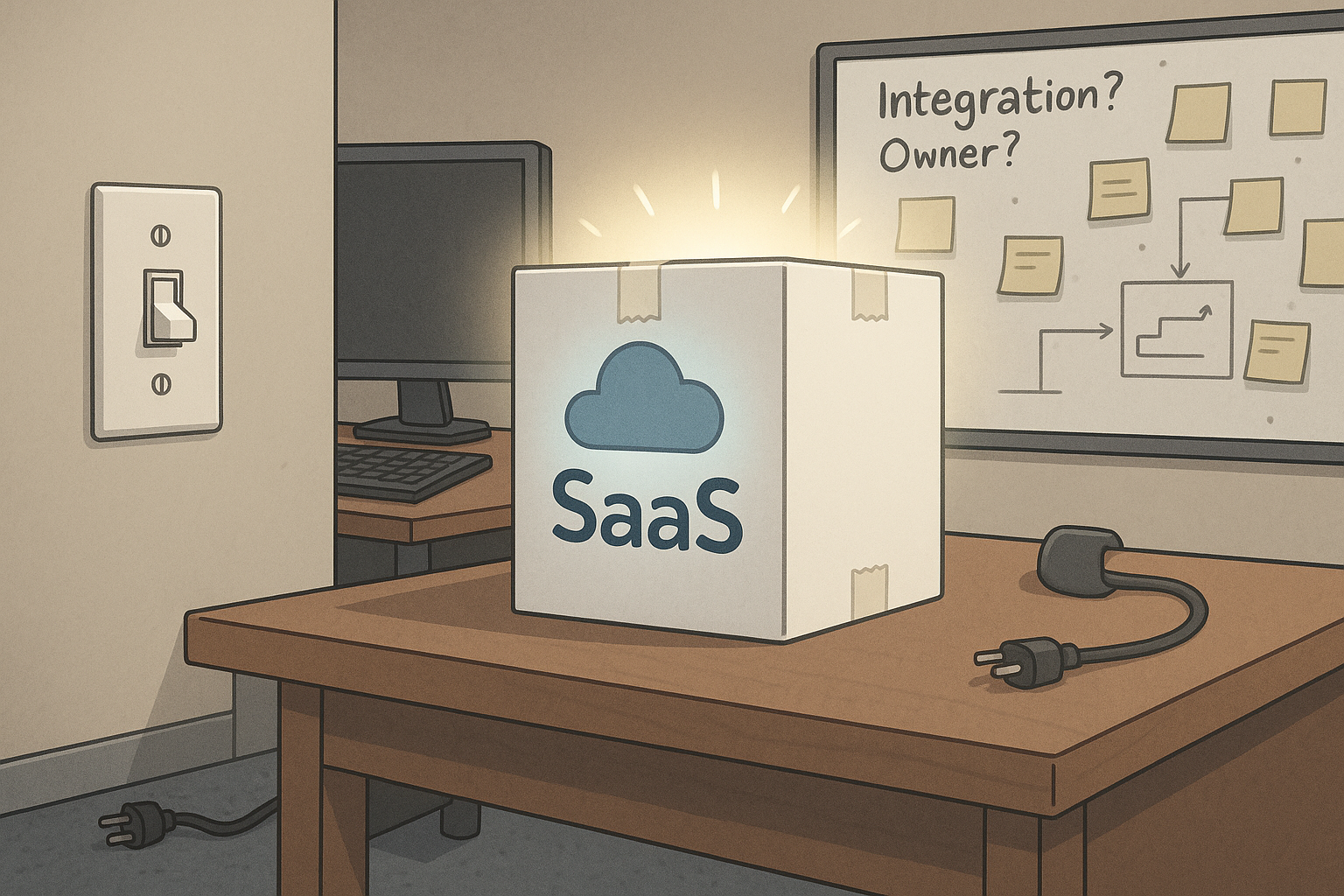We’ve all been there. An organization is stuck in legacy, processes are inefficient, and it takes an army of people to get things don. The solution? Buy a tool. And not just any tool — a SaaS product with a sleek interface, strong G2/Gartner reviews, and a demo that makes the future look like it will build itself. Contracts are signed. Seats are provisioned. Invites are sent. Then, weeks go by and very little changes. The old inefficiencies remain. The new workflows never materialize. The team is no more productive than before. Despite good intentions, nothing has improved. That’s because a SaaS tool doesn’t implement itself.
The Plug and Play Fallacy
The biggest myth in modern software adoption is the idea of plug and play. SaaS vendors are incentivized to promise ease of use, instant time to value, and minimal overhead. You hear terms like “no code,” “onboarding in minutes,” and “self-serve analytics.” It’s a compelling pitch, but quite often it doesn’t reflect reality. In practice, SaaS tools are not always as simple as flipping a switch. They require thoughtful planning, internal alignment, real process change, and a complex implementation: custom configuration, integration with other tools, data cleaning, training, and documentation. It means making decisions about who does what, how success is measured, and what workflows are changing. All of this takes time, coordination, and effort. The tool may be in the cloud, 21st century technology, but the work of making it useful is very much on the ground.
You’re Buying Potential, Not Outcomes
When your company buys a SaaS product, you’re not buying a fully-formed solution. You’re buying the possibility of improvement — the raw ingredients for a future capability. That distinction matters. The tool alone doesn’t create value. It requires internal ownership, embedded workflows, and active participation from the people who are supposed to benefit from it.
This is where most rollouts stall. Implementation teams often underestimate what it takes to go from contract to impact. Vendors will help, but only within the boundaries of what your internal team is able and willing to do. If your data is disorganized, core systems fragmented, or your use case is fuzzy, or you don’t have someone driving the rollout from your side, the tool won’t gain traction. And it won’t be the vendor’s fault.
Tools Don’t Create Alignment
The real challenge in implementing any new technology is not technical. It’s human. A tool can’t fix unclear priorities. It can’t resolve cross-functional misalignment. It can’t design a process or enforce accountability. A tool can support all of those things, but only after people agree on what they’re trying to accomplish and how they plan to work together.
Every successful rollout has someone who acts as the internal product manager for the tool. This person understands the business need, knows how the tool works, and takes responsibility for bridging the gap between the two. Without that champion, even the most powerful software will struggle to take root. It doesn’t matter how advanced the technology is if no one is actively leading its adoption.
Implementation is a Strategy, Not a Login
It’s easy to confuse provisioning access with delivering a solution. But logging in is not the same as onboarding, and onboarding is not the same as operational success. Before you introduce any new tool to your team, you need to answer some basic but critical questions. Who is responsible for implementation? What processes are changing? What does success look like in the first 30, 60, and 90 days? How will you know whether the tool is working?
A successful rollout requires more than just tech support and vendor check-ins. It requires intention. It requires communication. It requires a plan. Without that structure, most tools will fade into the background and eventually get categorized as shelfware — paid for but never used.
Lessons from the Field
Over the years I’ve seen this dynamic play out across many tools: accounts receivable automation platforms, pricing optimization engines, CRM systems, warehouse management, etc. At one company, we launched an A/R automation tool to accelerate billing and improve cash flow. On paper, it checked every box. But implementation became a struggle early on. We faced serious integration issues with our ERP and legacy systems, and the data migration from existing invoice records was incomplete and full of errors. Workflow disruptions and poor data quality eroded trust and adoption before the system could deliver.
In contrast, I’ve also been part of a rollout where we implemented a pricing optimization engine with strong internal coordination. We mapped our pricing logic in advance, validated our data sources, aligned stakeholders on success metrics, and ran controlled pilots before scaling. Implementation was slower, but it was cleaner. Within a few months, pricing became more dynamic, revenue improved, and adoption was frictionless. The difference wasn’t the tool itself — it was the rigor behind planning, and implementation.
Before You Buy, Ask These Questions
If you’re considering a new SaaS tool, it’s worth slowing down to ask a few key questions. Do we have a real, clearly defined problem we’re trying to solve? Is there someone on the team who is ready and willing to own this tool post-purchase? Are our data, processes, and people ready for the change? Have we budgeted not just dollars, but time and energy for implementation? Do we have a shared understanding of how we’ll measure success?
If you can’t answer these questions with confidence, it may be worth holding off. The best tools in the world won’t create impact if you’re not prepared to implement them well.
Final Thought
SaaS tools are multipliers. When your team is aligned and your processes are healthy, the right tool can accelerate your progress and unlock new capabilities. But when your foundation is shaky, the same tool can add complexity and confusion. It won’t fix misalignment. It won’t create strategy. And it definitely won’t implement itself. If you want the tool to work, you still have to do the work.
